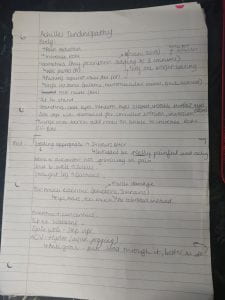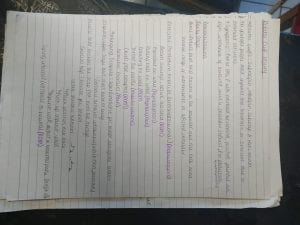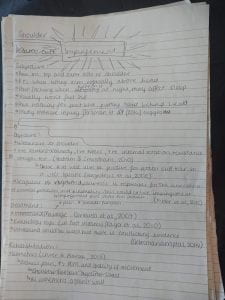Hours gained: 7
Total hours: 41
This week I had a total of four clients, two initial consultations and two follow-up appointments. The first client I had was a female who was complaining of lower back pain which came on three days ago when she was picking up her son. My immediate thought after hearing this was that the injury was discogenic, due to the client being in a loaded flexed position. The pain was localised to the lumbar spine and hadn’t travelled down the leg or foot. The main objective findings were that the client had increased side flexion, to the left, in a standing position, and that the client’s pain increased when flexing but relieved a little when extending. I also tested straight leg raise (SLR) which was 70° on the right and 45° on the left. I explained to the client what I found and that it indicates the pathology to be disc prolapse. I also went on to explain the treatment and that extension exercises help promote the disc to go back into place. I used McKenzie’s treatment as I knew it had helped people I tried it on. Whilst she was in the position I massaged her lower back to help relieve the taut and spasming muscles. I gave her the cat and camel stretch, the cobra or leaning into the wall if she couldn’t do the cobra due to pain, knee hugs, and glute bridges. I also explained how she could continue the McKenzie treatment at home. I felt very confident and knowledgeable during the session as it was a spinal pathology which I feel comfortable with. I feel I could’ve improved the way I explained the d=injury as she was getting very worried and anxious about it. Next time I could use one of the spinal models in the clinic to help illustrate it. I could also help by not using complex words that may increase fear.
My next client was another initial consultation. The client came in with pain in their outer left elbow that he had for a couple of weeks. During the subjective assessment, the client mentioned that he doesn’t know how or when the pain started. His pain increased when lifting any object, especially his granddaughter who lives with him and when playing golf which he does four times a week. The client’s ROM was full in the wrist, elbow, and shoulder however his pain increased when he fulling flexed his elbow. During palpation, tenderness was expressed over the muscles in the forearm and the lateral epicondyle. I asked Alex to help me with this case as I hadn’t come across an elbow case yet and didn’t feel as comfortable in diagnosing and treating. After presenting the subjective and objective assessments to her, she said it’s a straightforward case of tennis elbow (lateral epicondylitis) due to the overuse of the tendons in the lateral aspect of the elbow. She told the client what the diagnosis was and also helped me with the treatment and discussed the need to reduce or stop how much golf done for a couple of weeks as it is increasing the pressure on the tendons. I started with an STM for the forearm then moved on to exercises; towel grips, towel twists, and resisted flexion and extension of the wrist. Kinesiology tape was also used to help decompress the forearm and elbow (Dilek et al., 2016). When the pain was too much the client was also advised to use a cold compress or ice pack to help alleviate some pain. During this session, I felt the complete opposite of my first client, I lacked confidence as well as knowledge. To improve this, I could try and revise injuries so I have at least a baseline of every injury. I should know how and what they present like. Another way to help me better myself would be to write differential diagnoses of different injuries and how they differ in presentation of symptoms or special tests.
I had the next hour free and so I researched into tennis elbow and what the main signs and symptoms are. Tennis elbow or lateral epicondylitis affects 3% of the population and occurs due to the overloading of the extensor tendons of the forearm (Bisset et al., 2011). Tennis elbow is a self-limiting injury which means that it can get better on its own, however, rest is required (Bisset et al., 2011). Alex mentioned that you’d usually find tennis elbow amongst people who either golf, are manual labourers, garden a lot, and playing musical instruments that involve repetitive movements of the wrist. Typical symptoms are; pain in fully extending either the wrist or elbow, weak grip strength, and pain when lifting and gripping (Tosti et al., 2013).
The third client this week was a follow-up. This was the third week I’ve seen this client for his frozen shoulder and bicep strain. The pain had reduced to more of a “niggling” pain. The ROM had increased but the pain was still felt through abduction of the shoulder, mainly 90° to 100°. There was also pain on external rotation. My treatment remained the same as I knew it was working. It started with an STM over the shoulder and biceps. Then I did laser therapy over the anterior and posterior head of the humerus and then I reviewed the exercises. This week the client thought that the exercise “throw salt over your shoulder” wasn’t helping or working anything so we decided to drop that one. I then added the original lateral raises as I had modified them for him before. This was also another way to see progression.
My next hour was free so I decided to shadow one of the other therapists to see how our treatments differ. The therapist had a case of lower back pain (LBP) and was an initial client. The therapist was struggling with diagnosing the injury which turned out to be facet joint dysfunction in L4 and L5. The therapist then did PAs on those levels to try and increase movement and then gave the client exercises.
I had a follow-up appointment after the shadowing session, who was suffering from facet joint stiffness in her cervical and thoracic spine. As per the plan I wrote last time, I first conducted central PAs on T4, T7, and T9 which I didn’t have time for during the last session. I did these movements in grade 2 for 60 oscillations for 3 sets which were also different from the last session. I increased the grade and the oscillations as the client could take it and it was the recommended amount (Ganesh et al., 2015). I also massaged the client’s upper back and shoulders to help work into the adhesions found last time. This client refused to take exercises last time so I knew I couldn’t do any more other than ask if she had changed her mind. She hadn’t. During this session, I felt like I had become confident again because I knew exactly what I had to do. It also helped that the client already felt better after one session.
The last hour was spent writing up notes, helping anyone that needed it and asking Alex about using the right words to communicate certain topics. I wanted to know how to talk to people that come in with discogenic problems as they often become very panicked and fearful that they’ll have to undergo surgery. I was told that it all comes down to educating them and helping them understand that its a very common pathology that only needs exercise to help it. This helped me a lot as I realised that as long as you reassure the client that they will be fine, they’ll listen to you. I also became more aware of how you can converse with a client in a more efficient way.
Bisset, L., Coombes, B. and Vicenzino, B. (2011) Tennis Elbow. British Medical Journal of Clinical Evidence. Vol. 6, No. 1: 1-35.
Dilek, B., Batmaz, I., Sariyildiz, M. A., Sahin, ., Ilter, L., Gulbahar, S., Cevik, R. and Nas, K. (2016) Kinesio taping in patients with lateral epicondylitis. Journal of Back and Musculoskeletal Rehabilitation. Vol. 29, No. 4: 853-858.
Ganesh, G. S., Mohanty, P., Pattnaik, M. and Mishra, C. (2015) Effectiveness of mobilization therapy and exercises in mechanical neck pain. An International Journal of Physical Therapy. Vol. 3, No. 2: 99-106.
Tost, R., Jennings, J. and Sewards, J.M. (2013) Lateral Epicondylitis of the Elbow. The American Journal of Medicine. Vol. 126, No. 4: 357.








